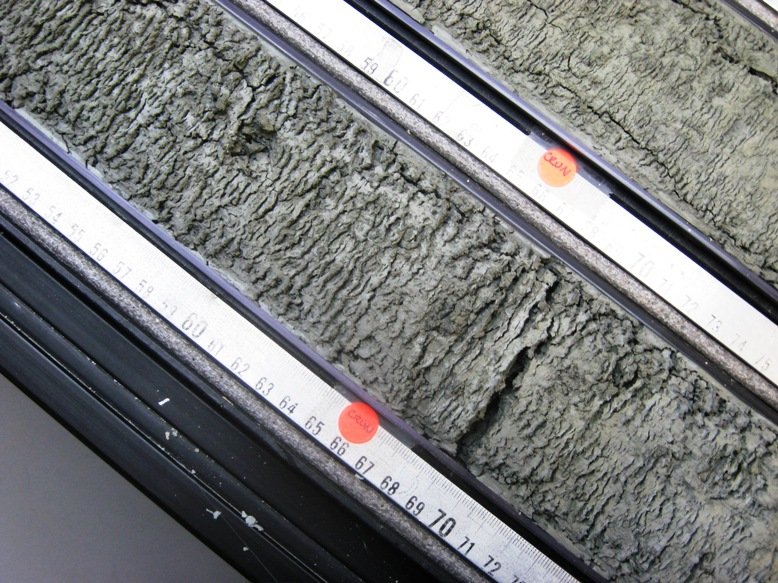
Describing the Core
I have talked about how the samples are taken, and how the cores are split and tested for physical properties. What I haven’t talked about much is what we’re seeing in these cores.
At our current site, we are drilling through about 300 m of ocean to reach the sea floor. At this location, we are drilling on the continental slope – this is the part of the continental crust that starts to slope down to the deepest parts of the ocean – the abyssal plains. The sediments coming up have fallen in to two basic groups. The most obvious way to distinguish the two sediment types is by color. Parts of the cores are a gray color, while other parts are an olive green. The colors give us some hints about the sediment – but let me show you what I mean first – below is picture of a single split core from site 1352 B – you can see the two different colors really well.

The grey sediments are in this picture are found at the top of the core, and as you move downward, it changes to the olive green you see on the left. The gray colored sediments are mainly muds, very fine grained and a bit sticky. When the color changes to the green, the sediments have more sand in them. They also contain much higher amounts of Calcium Carbonate, or Calcite. This is the mineral that many sea organisms make their shells from. Calcite is white, but there is some chemical reaction happening where it it present that is causing the greenish color in the core. So – the grey is mud, the green is sandy mud with lots of calcite. The really neat thing is that the tests the geochemists are doing are finding high amounts of Calcium Carbonate in the pore waters for these green layers – so their data agrees quite nicely with what the sedimentologists are finding. Now lets talk about concretions. What, you ask, is a concretion? Take a look:


Concretions are places in the sediment where the calcite we were talking about has “gone into solution”, or dissolved in the sea water. When conditions are right, it solidifies back into crystals and those tiny crystals act like glue between sediment grains, making them stick together. These concretions are harder than the surrounding sediment, and can sometimes break the wire on the core splitter. The solid looking chunks in these cores are concretions. These tiny crystals can sometimes “nucleate” or start from a center point like a fragment of shell and form outwards – just like a pearl forms outwards in layers around a sand grain irritating an oyster. When the concretions form like this, they are often almost perfect ball shape, and called “nodules”

Here is a nodule in the Core Catcher (very bottom of the core) section.
So, that is a little bit about what sediments we are seeing at site two. I’ll let you know if we find more of the same at Hole C – our third hole for this site. Thank you to Helen Lever for the sedimentology lesson – any mistakes above are totally mine, not hers!